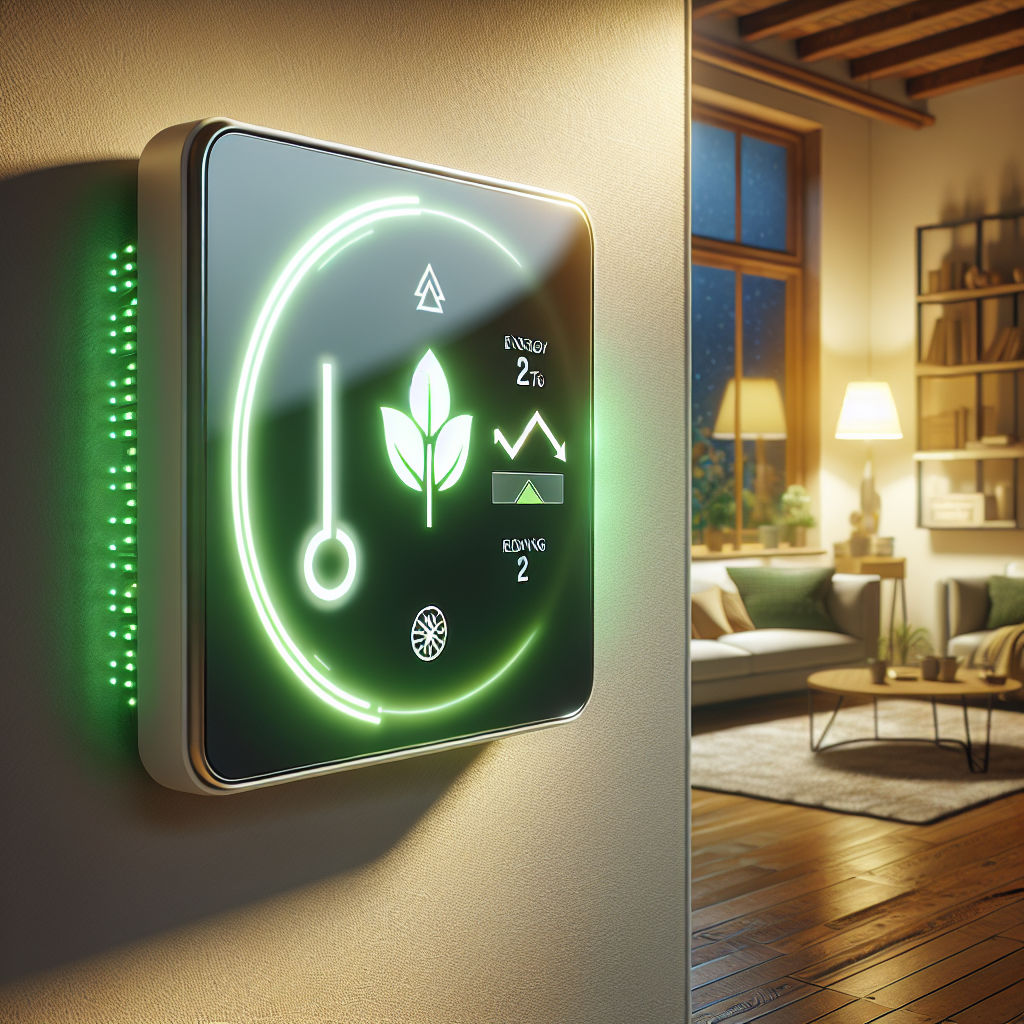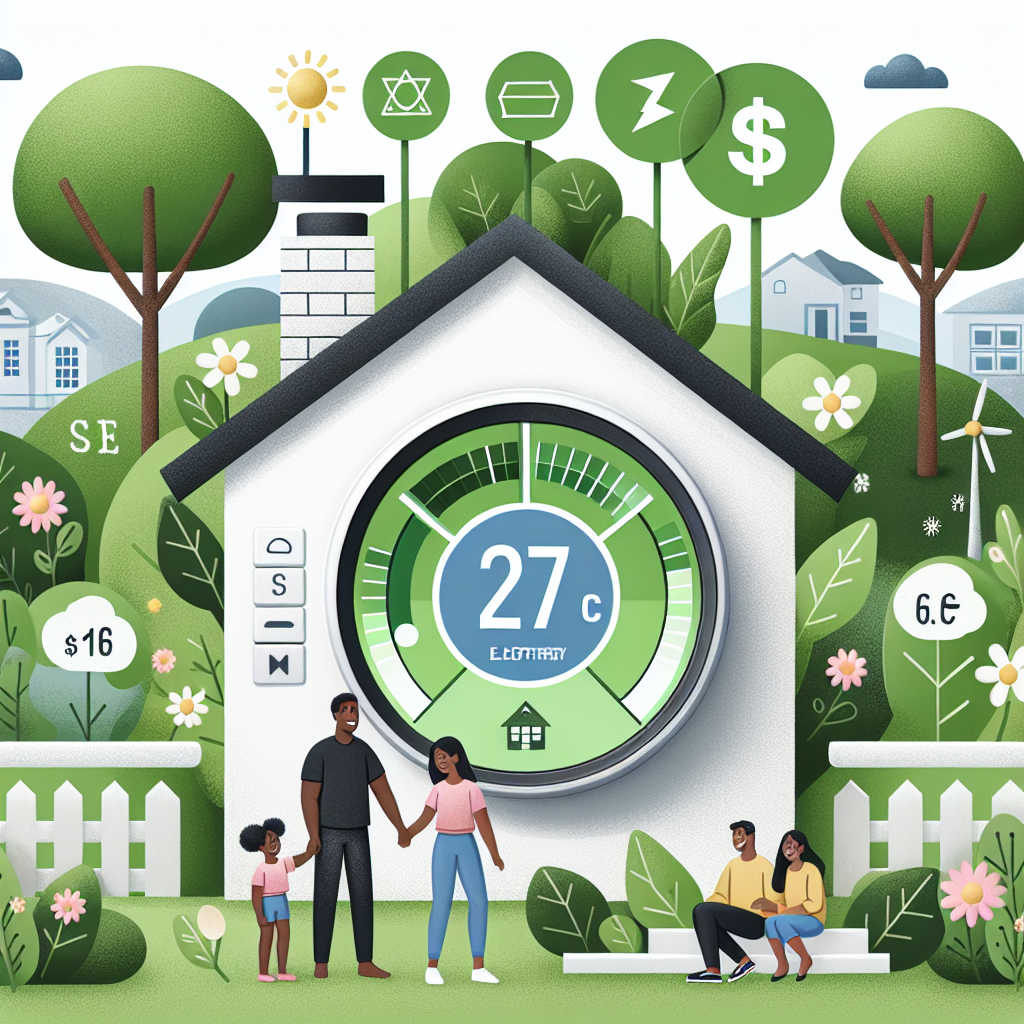Imagine having complete control over your home’s temperature, all while saving energy and reducing your monthly bills. That’s exactly what smart thermostats offer, with a range of energy-saving features that can revolutionize the way you heat and cool your living spaces. These intelligent devices not only provide precise temperature control but also make smart adjustments based on your daily routine, allowing you to effortlessly optimize energy usage without compromising comfort. In this article, we will explore some of the remarkable energy-saving features that smart thermostats bring to the table. So, get ready to discover a more efficient and eco-friendly way to regulate your home’s temperature.

Optimized Scheduling
Smart thermostats come equipped with numerous energy-saving features, and one of the most prominent ones is optimized scheduling. With this feature, you can easily set up a daily or weekly schedule for your thermostat, allowing it to automatically adjust the temperature based on your preferences. By programming your thermostat to lower the temperature while you’re away or asleep, and raise it when you’re at home, you can efficiently manage your energy usage and reduce unnecessary heating or cooling. This not only ensures that your home is always at a comfortable temperature when you need it, but also helps to save on energy costs.
Learning Schedule Patterns
To make scheduling even more convenient, smart thermostats have the ability to learn your schedule patterns over time. By using advanced algorithms, these thermostats can analyze your temperature preferences and occupancy patterns to create a personalized schedule that fits your lifestyle. This means that the thermostat will eventually learn when to heat or cool specific zones of your home based on your previous usage patterns. By adapting to your schedule, the thermostat can ensure that your home is always at the right temperature without unnecessary energy waste.
Adaptive Scheduling
Smart thermostats also offer adaptive scheduling, which takes into account factors such as weather conditions and occupancy patterns to make real-time adjustments to your schedule. This feature allows the thermostat to automatically adjust the temperature based on unexpected changes in your routine or the climate, ensuring optimal comfort while minimizing energy consumption. For example, if you usually come home at 6 PM but are delayed, the thermostat can detect your absence and adjust the temperature accordingly, preventing unnecessary heating or cooling.
Geofencing
Another energy-saving feature of smart thermostats is geofencing. Geofencing utilizes the location services on your smartphone to determine when you are within a certain radius of your home. By setting up a geofence, you can program your thermostat to automatically adjust the temperature whenever you leave or enter the specified area. This means that when you leave for work or go on vacation, the thermostat can switch to an energy-saving mode, reducing unnecessary heating or cooling. And as you approach your home, it can automatically start adjusting the temperature back to your desired comfort level, ensuring a warm or cool welcome.
Vacation Mode
When you’re away from home for an extended period, such as during a vacation, smart thermostats offer a vacation mode feature to further reduce energy consumption. By activating vacation mode, the thermostat will adjust the temperature to a predetermined energy-saving setting and maintain it until you return. This ensures that your home remains at a more economical temperature in your absence, helping to conserve energy and lowering your utility bills. Additionally, some smart thermostats allow you to remotely control and monitor the temperature while you’re away, giving you peace of mind and the ability to make adjustments if needed.
Temperature Control
Smart thermostats provide a range of features to help you optimize and control the temperature in your home.
Setpoint Adjustment
The ability to adjust the setpoint temperature is a fundamental feature of smart thermostats. Setpoint adjustment allows you to easily regulate the target temperature for your heating and cooling system, providing you with precise control over your home’s climate. Whether you prefer a toasty warm winter or a comfortably cool summer, you can customize the setpoint temperature to suit your preferences and optimize energy efficiency.
Zone Control
Zone control is an advanced feature offered by some smart thermostats, allowing you to divide your home into separate temperature zones. With zone control, you can independently regulate the temperature in different areas of your home, ensuring personalized comfort while minimizing energy waste. For example, you can set a higher temperature in the living room during a gathering while keeping the bedrooms cooler to save energy. This level of control is particularly beneficial for larger homes or multi-story buildings, where different areas may have varying heating and cooling needs.
Pre-cooling and Pre-heating
Smart thermostats often come equipped with pre-cooling and pre-heating capabilities, which provide a proactive approach to temperature control. By utilizing built-in sensors and algorithms, these thermostats can predict when you’re likely to adjust the temperature and proactively pre-cool or pre-heat to reach the desired temperature faster. For instance, if you usually arrive home at 5 PM, the thermostat can start cooling the house a few minutes earlier to ensure it reaches your preferred temperature as soon as you step through the door. This feature not only ensures optimal comfort but also helps to reduce energy waste by minimizing the time your HVAC system operates at full power.
Temperature Lock
To avoid accidental changes to your desired temperature settings, smart thermostats often offer a temperature lock feature. Temperature lock allows you to set a specific temperature range within which the thermostat can be adjusted. This feature is especially useful if you have children or guests who may unknowingly change the settings. By locking the temperature range, you can maintain control over your energy usage and prevent sudden temperature fluctuations that could lead to unnecessary energy consumption.

Smart Sensors and AI
Smart thermostats leverage advanced sensors and artificial intelligence capabilities to enhance energy-saving capabilities.
Occupancy Detection
Occupancy detection is a key feature of smart thermostats that helps optimize energy usage. By using motion sensors or other smart devices, the thermostat can detect if there are people present in a specific area or room. This information is then used to adjust the temperature accordingly. For example, if no movement is detected in a room for a certain period, the thermostat can automatically adjust the temperature to an energy-saving level or even turn off the heating or cooling for that zone. By avoiding unnecessary temperature regulation in unoccupied areas, occupancy detection helps to save energy and reduce utility bills.
Temperature and Humidity Monitoring
Smart thermostats incorporate temperature and humidity sensors to provide accurate readings of your home’s climate. These sensors constantly monitor the temperature and humidity levels, allowing the thermostat to make informed decisions about temperature adjustments. By considering both temperature and humidity, the thermostat can optimize energy usage by adjusting the temperature based on the current climate conditions. For instance, if the humidity level is high, the thermostat can cool the air slightly more to provide better comfort without overworking the HVAC system.
Weather Data Integration
To further enhance temperature control, many smart thermostats integrate weather data into their algorithms. By receiving real-time weather updates, the thermostat can make more accurate predictions and adjustments to your home’s temperature. For example, if the forecast indicates a sudden drop in temperature, the thermostat can proactively increase the heat in your home to ensure it remains comfortable without wasting energy. By considering external weather conditions, your smart thermostat can optimize energy usage and adapt to changing climate patterns.
Machine Learning Algorithms
Smart thermostats utilize machine learning algorithms to continuously analyze and learn from your temperature preferences and usage patterns. Over time, the thermostat becomes more efficient at predicting and adjusting the temperature based on your unique needs. By analyzing data such as the time you wake up, leave home, and return, as well as your preferred temperature settings, the thermostat can create a personalized temperature schedule that maximizes comfort and minimizes energy consumption. As the thermostat continues to learn, it adapts to changes in your routine and makes proactive adjustments, further optimizing energy efficiency.
Energy Usage Monitoring
Smart thermostats provide detailed insights into your home’s energy consumption, helping you identify areas for improvement and make informed decisions about energy usage.
Real-time Consumption Data
One of the key features of smart thermostats is the ability to provide real-time energy consumption data. With this feature, you can monitor how much energy your HVAC system is using at any given time, allowing you to have a clear understanding of your energy usage habits. By seeing the impact of temperature adjustments on energy consumption in real-time, you can make informed decisions to optimize energy usage without sacrificing comfort.
Historical Usage Analysis
In addition to real-time data, smart thermostats also offer historical usage analysis. This feature allows you to view detailed reports and graphs that show your energy usage patterns over time. By analyzing these reports, you can identify trends and patterns in your energy consumption and make adjustments accordingly. For example, if you notice that you consistently use a lot of energy during specific times of the day, you can modify your schedule or temperature settings to reduce energy waste during those periods.
Monthly Reports and Recommendations
Some smart thermostats go a step further by providing monthly energy reports and personalized recommendations. These reports summarize your energy usage for the month, highlighting areas where you can improve energy efficiency. Additionally, the thermostat may offer suggestions on how to adjust your temperature settings or schedule to save energy without sacrificing comfort. By following these recommendations, you can optimize your energy usage and reduce your environmental footprint.
Appliance Integration
To provide a complete overview of your home’s energy usage, smart thermostats often integrate with other home appliances, such as smart plugs or energy monitoring devices. This integration allows you to monitor the energy consumption of individual appliances, identifying any potential energy-draining devices. By knowing which appliances consume the most energy, you can make informed decisions about their usage or consider more energy-efficient alternatives. This holistic approach to energy monitoring helps you maximize energy savings and optimize your home’s overall energy efficiency.

Intelligent Adaptation
Smart thermostats possess intelligent features that enable them to adapt to changing circumstances and optimize energy consumption.
Self-adjusting Setpoints
One of the key advantages of smart thermostats is their ability to self-adjust setpoints based on various factors. By considering factors such as occupancy, outdoor temperature, and time of day, the thermostat can automatically adjust the setpoint temperature to ensure optimal comfort while minimizing energy waste. For example, if the outdoor temperature suddenly increases, the thermostat can raise the setpoint temperature slightly to avoid unnecessary cooling, saving energy in the process. This self-adjusting feature allows the thermostat to continuously adapt to changing conditions and optimize energy consumption.
Seasonal Temperature Adjustments
Smart thermostats can also make seasonal temperature adjustments to optimize energy usage. By analyzing historical weather data and user preferences, the thermostat can anticipate seasonal changes and proactively adjust the setpoint temperature accordingly. For instance, as winter approaches, the thermostat may slightly lower the setpoint temperature to save energy, and as summer arrives, it can raise the setpoint to minimize unnecessary cooling. By making these seasonal adjustments, the thermostat helps maintain a comfortable indoor environment while maximizing energy efficiency.
Away Mode Activation
Smart thermostats offer an away mode feature that activates automatically when you’re not at home. Away mode ensures that your HVAC system operates at an energy-saving level while you’re away, reducing energy consumption. The thermostat can detect your absence either through occupancy sensors, geofencing, or based on your smartphone’s location. Once activated, the thermostat adjusts the temperature to a more economical setting, minimizing energy waste. When you return home, the thermostat can automatically switch back to your preferred comfort settings, ensuring a comfortable environment upon your return.
Optimal Start and Stop
To further optimize energy usage, some smart thermostats employ optimal start and stop features. These features leverage algorithms and predictive capabilities to start or stop heating or cooling in advance, ensuring that your home reaches the desired temperature at the right time. For instance, instead of running the HVAC system continuously to reach the target temperature at the scheduled time, the thermostat calculates the ideal time to start heating or cooling, ensuring energy savings without compromising comfort. By starting or stopping the HVAC system at the optimal time, smart thermostats minimize energy waste and reduce overall energy consumption.
Smart Home Integration
Smart thermostats seamlessly integrate with other smart devices and systems, offering enhanced control and efficiency.
Interaction with other Smart Devices
Smart thermostats can interact and integrate with other smart devices in your home, adding convenience and automation to your daily routines. For example, they can connect with smart lighting systems, allowing lights to automatically turn on or off when you enter or leave a room. They can also integrate with smart blinds or curtains, adjusting them based on the sun’s position to maximize natural lighting or heat gain. By integrating with other smart devices, thermostats can create a holistic smart home environment that optimizes energy usage and enhances comfort.
Voice Control
Smart thermostats often feature voice control capabilities, allowing you to adjust the temperature or activate specific settings using voice commands. By integrating with voice assistants such as Amazon Alexa or Google Assistant, you can control your thermostat hands-free and effortlessly. Whether you’re in another room or just want to avoid touching the thermostat, voice control provides a convenient way to manage your home’s temperature. This integration with voice assistants further enhances the user experience and adds an extra layer of efficiency to your smart home.
Integration with Energy Management Systems
For users who want to take their energy management to the next level, smart thermostats can integrate with energy management systems. These systems provide advanced energy monitoring and control functionalities, allowing you to optimize energy usage across your entire home. By integrating your smart thermostat with an energy management system, you can benefit from additional insights and controls, such as load balancing or demand response programs. This integration offers a comprehensive solution for maximizing energy efficiency and reducing utility costs.
Intuitive Mobile Apps
Smart thermostats typically come with intuitive mobile apps that provide easy access to their features and settings. Through these apps, you can remotely monitor and control your thermostat from anywhere with an internet connection. Whether you’re at work, on vacation, or simply in another room, you can adjust the temperature, tweak the schedule, or activate energy-saving modes directly from your smartphone. This remote access and control give you the flexibility to manage your home’s temperature efficiently and ensure your comfort, no matter where you are.

Remote Access and Control
Smart thermostats offer various methods of remote access and control, enabling you to manage your home’s temperature anytime, anywhere.
Connectivity via Wi-Fi
To enable remote access, smart thermostats connect to your home’s Wi-Fi network. This connection allows the thermostat to communicate with your smartphone, tablet, or other compatible devices, providing you with remote control capabilities. By connecting to Wi-Fi, the thermostat can receive commands or adjustments from your mobile app and send real-time data to your device, allowing you to monitor and control the temperature settings from virtually anywhere.
Mobile App Control
The primary method of remote access and control is typically through a dedicated mobile app. The app allows you to access all the thermostat’s features and settings from your smartphone or tablet. From the app, you can adjust the temperature, set schedules, activate energy-saving modes, or receive energy consumption reports. The mobile app provides a user-friendly and convenient interface, ensuring that you have complete control over your home’s temperature, even when you’re not physically present.
Web-based Control
In addition to mobile app control, some smart thermostats offer web-based control. This means that you can access and control your thermostat’s settings using a web browser on any internet-connected device, such as a laptop or desktop computer. Web-based control provides an alternative method of remote access, offering a similar experience to mobile app control. Whether you prefer using your smartphone or computer, smart thermostats enable you to manage your home’s temperature according to your preferences and energy-saving goals.
Integration with Home Assistants
Smart thermostats often integrate seamlessly with popular home assistant devices like Amazon Echo or Google Home. By linking your smart thermostat to a home assistant, you can control the temperature using voice commands or through the assistant’s interface. This integration adds an extra layer of convenience, allowing you to adjust the temperature without even needing to pick up your smartphone or access the mobile app. Whether you prefer to use voice control or a touch-enabled screen, smart thermostats offer a range of options to ensure remote access and control of your home’s temperature.
Learning Algorithms
Smart thermostats leverage learning algorithms and data analysis to optimize energy usage and enhance comfort.
Behavior Analysis
Learning algorithms in smart thermostats can analyze your behavior and patterns to better understand your temperature preferences. By tracking your adjustments, occupancy patterns, and previous temperature settings, the thermostat can create a personalized profile that reflects your unique comfort needs. This behavior analysis allows the thermostat to anticipate your temperature preferences and automatically adjust the temperature to ensure optimal comfort without unnecessary energy waste.
Adaptive Algorithm
To further enhance energy savings, smart thermostats employ adaptive algorithms that continuously learn and adapt to your changing needs. These algorithms take into account various factors such as time, weather conditions, occupancy, and user preferences to optimize temperature settings. By continuously adjusting the temperature based on these factors, the thermostat can maintain a comfortable environment while minimizing energy consumption. The adaptive algorithm ensures that the thermostat is always working in harmony with your lifestyle and provides the most energy-efficient temperature control possible.
Pattern Recognition
Pattern recognition is a key component of smart thermostat algorithms. By analyzing your historical temperature settings and occupancy patterns, the thermostat can identify recurring patterns and trends. This analysis allows the thermostat to anticipate your temperature preferences and proactively adjust the temperature accordingly. For example, if you typically lower the temperature before going to bed, the thermostat can start adjusting the temperature earlier to reach your desired level at the right time. By recognizing patterns, smart thermostats optimize comfort and energy efficiency.
Occupancy Prediction
Smart thermostats can also predict occupancy based on historical data and previous patterns. By analyzing your past occupancy patterns, the thermostat can make educated guesses about when you’re likely to be at home or away. This prediction capability allows the thermostat to adjust the temperature based on anticipated occupancy, ensuring that your home is at the desired comfort level when you need it while saving energy during periods of absence. By predicting occupancy, smart thermostats maximize energy efficiency and provide an enhanced user experience.

Energy Saving Tips and Suggestions
In addition to their built-in energy-saving features, smart thermostats offer various tips and suggestions to help you further reduce energy consumption.
Optimal Temperature Range
Smart thermostats often provide recommendations for an optimal temperature range that balances comfort and energy efficiency. By setting your thermostat within this recommended range, you can maintain a comfortable indoor environment without excessive energy usage. The optimal temperature range may vary depending on the season, climate, and personal preferences. By adhering to these recommendations, you can ensure efficient energy usage while still enjoying a comfortable home.
Efficient HVAC System Usage
Smart thermostats can offer guidance on how to efficiently use your HVAC system to conserve energy. For example, they may suggest using features like fan-only mode during mild weather instead of relying on heating or cooling. They may also recommend adjusting temperature settings by a few degrees to achieve energy savings without sacrificing comfort. By following these guidelines, you can optimize your HVAC system’s efficiency and reduce unnecessary energy consumption.
Integration with Renewable Energy Sources
Smart thermostats may provide integration options with renewable energy sources, such as solar panels or wind turbines. By linking your smart thermostat to these renewable energy systems, you can maximize energy savings and reduce your reliance on non-renewable sources. The thermostat can adjust the temperature settings based on the availability of renewable energy, ensuring efficient usage and contributing to a greener, more sustainable home.
Energy-saving Recommendations
Smart thermostats often offer personalized energy-saving recommendations based on your specific usage patterns and adjustments. These recommendations may include adjusting temperature schedules, activating energy-saving modes, or making small changes to your daily routines. By following these suggestions, you can optimize your energy usage and reduce your environmental footprint. The personalized nature of these recommendations ensures that you receive tailored advice that aligns with your energy-saving goals.
Customized Settings
Smart thermostats offer a range of customized settings that allow you to personalize your comfort and energy-saving preferences.
Personalized Comfort Profiles
With personalized comfort profiles, smart thermostats enable you to create customized temperature settings for different times of the day or different zones within your home. For example, you can set the temperature slightly lower while you sleep, and higher when you wake up, ensuring optimal comfort during each part of your day. By tailoring the temperature settings to your preferences, you can create a personalized comfort profile that maximizes energy efficiency without compromising comfort.
Multiple User Accounts
Smart thermostats often support multiple user accounts, allowing each member of your household to have their own personalized settings and temperature preferences. With multiple user accounts, each person can create their own comfort profiles, adjust settings according to their preferences, and receive tailored energy-saving recommendations. This customization ensures that everyone in your home can enjoy their preferred level of comfort while minimizing energy consumption.
Time and Temperature Zoning
Time and temperature zoning allows you to divide your home into different zones, each with its own temperature settings. This feature enables you to optimize energy usage by controlling the temperature independently in different areas of your home. For example, you can set a higher temperature in the living room during the day while keeping the bedrooms cooler. Time and temperature zoning ensure personalized comfort while reducing energy waste in unoccupied or unused areas.
Adaptable Preferences
Smart thermostats offer adaptable preferences that allow you to make adjustments as your needs change. Whether it’s a change in occupancy, routine, or climate, you can modify your preferences to ensure continued energy efficiency. For example, if you start working from home regularly, you may want to adjust the temperature schedule to reflect your new routine. By providing adaptable preferences, smart thermostats accommodate changes in your lifestyle and ensure that you maintain optimized energy usage.
In conclusion, smart thermostats offer a multitude of energy-saving features that help optimize temperature control, enhance energy usage monitoring, provide intelligent adaptation, enable smart home integration and remote access, and leverage learning algorithms for efficient operation. With their advanced capabilities and personalized settings, smart thermostats allow you to maximize comfort while minimizing energy consumption, ultimately reducing your environmental impact and lowering your utility bills. By investing in a smart thermostat, you not only gain convenience and control over your home’s temperature but also contribute to a greener and more energy-efficient future.










